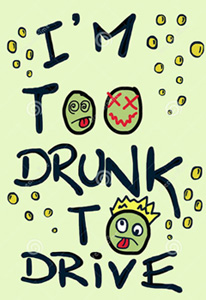How to Know If You Are Too Drunk to Drive?

So, you have been hanging out with your friends, or just had a meeting with some colleagues, or were called to a local bar for a chat and a glass of wine. People around you kept saying that you had already had too much to drink, but you are planning to have another drink. You needed to get home and your car is parked right outside. You want to know how impaired are you and if it is safe to drive. Let’s look at some ways to help you figure out if you are too drunk to drive.
If you are wondering how drunk you may be or whether you need to call a cab or Uber instead of driving yourself; you already have the answer. You should not get behind the wheel. The best approach if you consume alcohol is not to drive. Call a cab or call a friend and do not be near your vehicle because in some jurisdictions you can get arrested merely because you are in control of the vehicle. If however, you are considering driving despite consuming alcohol, here are some helpful tips that may help you determine if you are impaired.
Never lose count of drinks
One possible way to stay below the legal limit is to track the number of alcoholic drinks you had. For a non-commercial adult driver who is not on DUI probation, to avoid a DUI, which is a violation of California Vehicle Code 23152(b), the blood alcohol level (BAC) must be lower than 0.08%. BAC is calculated as grams of alcohol per 100 milliliters of blood or grams of spirits per 210 liters of breath. For an average person, it translates to about one drink per hour. “One drink” refers to one standard glass of wine, one shot of a spirit such as vodka, or 12 ounces of beer.
Because most people are not average, individual body characteristics such as weight, height, gender, diet characteristics, medical conditions, the kind of alcohol consumed, psychological state, fatigue, and other individual unique characteristics can affect blood alcohol levels. No one knows better than you how quickly you get drunk, or how much you may drink.
Further, some people might be below the legal limit of .08% but still too drunk to drive. For example, a person who consumes alcohol rarely will be affected faster by alcohol and can exhibit signs of intoxication at a level below .08% BAC. California law allows the prosecution of drivers who are too impaired to drive in violation of California Vehicle Code section 23152(a). This covers cases where the alcohol level is unknown, such as with a refusal case, and cases where the alcohol level is below the legal limit of .08% BAC. And yet, a conviction of this code section is still a DUI conviction.
Alcohol may stay in your circulatory system for up to 18 hours. As such, taking a quick nap, a cold shower, or having a strong cup of coffee might increase your ability to focus but it will not reduce the alcohol level in your body beyond your body’s natural alcohol elimination mechanism.
Objective Signs of Alcohol Intoxication
The following are obvious signs of drunkenness:
- smell of alcohol
- poor coordination
- slurred speech or deliberate speech
- hand tremors
- changes in facial skin color and/or bloodshot eyes
- a decrease in sensory perception
- changes in behavior such as exaggerated gaiety, loud singing/talking, flirting, outrageous language, aggressiveness, etc.
Short-time Memory Loss
While under the influence of alcohol, you may experience short-time memory loss. A good way to check this is for your friends to question you about what you’ve just talked about. They can help you figure out if you are too impaired to drive. If you can’t recall or your thoughts are jumbled together, that may help you determine that you had one too many.
Finger-to-Nose Test
This is another helpful test to check whether you are too drunk to drive. This test is a commonly used police tool to investigate DUIs. To see if you do well on this test, you need to stand straight with your feet together and your eyes closed. The hands should be to your sides from where you can touch the tip of your nose several times with the right-hand index finger and then the left one. You may also tilt your head back a little bit. If you fail to touch the tip of your nose, you are probably experiencing a lack of coordination connected with alcohol impairment. Touching the bridge of the nose or not using the very tip of the finger is an indication of impairment.
Online Blood Alcohol Calculators
To work out a more precise level of alcohol concentration in your bloodstream, several online sites, such as educalcool.qc.ca will allow you to fill in an online form listing your sex, weight, and number of alcohol servings before, after, and with your meals. Next, you will need to indicate the time when you started drinking and the time when you stopped drinking. It’s better to make these calculations before you start drinking. These results show an estimate of BAC. It is designed to help you make the right decision, but not decide for you.
Modern Technologies to Help You Avoid DUI
There are numerous breath-alcohol portable devices that may be used to measure blood alcohol levels. For example, a breathalyzer is a portable breath-in device that will tell you the alcohol level in your breath. You just breathe into the device and it estimates your BAC. The accuracy of results depends on the quality of a breathalyzer and on other factors, such as the stage of alcohol metaboliss and unique physiological qualities. With modern technologies today, you may even measure your BAC with the help of apps on your phone. One of them is Breathometer. You plug it into the audio jack of your smartphone, connect it to the special application and blow into its outlet port. If your BAC is beyond the acceptable level, it’ll display the names of your friends living nearby, phone numbers of taxi services, or addresses of hotels down the street. Many other apps provide you with the history of your alcohol consumption and BAC levels, so that you may trace your body’s reactions to alcohol.
Field Sobriety Tests
The US National Highway Traffic Safety Administration (NHTSA) established a series of tests to determine if a person is supposedly driving in a state of alcoholic intoxication. These tests, known as Field Sobriety Tests, are usually offered by Los Angeles and other DUI enforcement police officers when investigaint a DUI at the scene when they stop an allegedly impaired driver. Trying these tests yourself could be very beneficial when you need to check your level of drunkenness. You will get the most credible results if you perform all three tests.
The Horizontal Gaze Nystagmus (HGN) Test. You will need someone to assist you. Ask this person to move his/her finger or an object slowly back and forth in front of your eyes in the horizontal direction only. The object should be 12 to 15 inches from your face and ideally, it should be a pen or a stylus. Do not turn your neck or head, just track the object with your eyes. If you are sober, your eyes will move smoothly. If you are under the influence of alcohol, your eyes might jerk involuntarily. Keep in mind that over 25% of people will display HGN at all times and some people have medical conditions that will cause nystagmus. Because of that, this test alone may not be enough to determine your level of impairment.
Walk-the-Line Test. If you are on your own try to perform the walk-and-turn-test. You just need to find a flat surface and walk an imaginary line on the ground. The NIHTSA instructions are to walk 9 steps forward, heel to toe, turn and walk back along the line. During the test it is important not to lose balance, use your arms to keep balance, or step-off the line. Law enforcement are looking for any diviation from instructions, such as taking wrong number of steps, inability to touch heel to toes, stepping off the line etc. Any violations are considered a “clue” of impairement and should be used to reconsider driving.
The One-Leg Stand (OLS) Test. Try to balance on one foot while your second foot is raised above ground about six inches with your arms to your sides while counting until 30. Hopping, swaying, lifting arms more then 6 inches from sides, or touching the ground with your raised foot are considered clues.
There are lots of other ways to check your impairment level, for example, reciting the alphabet, counting backward, saying tongue twisters, counting fingers by touching each finger to the thumb, and doing physical exercises or mathematic calculations. The above tests are most commonly used by law enfrocement in Los Angeles DUI prosecution and the surest method to measure the blood alcohol concentration (BAC) is to perform a breath or blood test, which you will be asked to do if you are arrested for DUI in Los Angeles.
If you were arrested for DUI in Los Angeles or nearby counties (Orange County DUI, San Bernardino County DUI), call Los Angles Criminal Defense Attorney and Los Angeles DUI attorney ASAP. Let us help you with our experience and knowlege to win your Los Angeles DUI case.
(818) 921 7744 Call anytime to get a free consultation with Los Angeles DUI Attorney.
YOU MAY ALSO BE INTERESTED IN:


 (42 rating, 10 votes)
(42 rating, 10 votes)